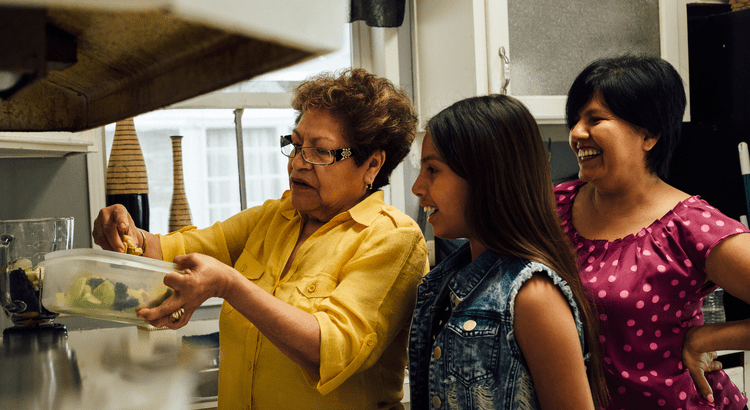This Tech Company’s ‘Chief Parent Officer’ Works To Keep Kids Safe Online. 4 Things She Wants You To Know
Fortune Well August 10, 2023
Lifestyle

Fortune Well August 10, 2023
Lifestyle

Children can stay up and connect 24/7, use an app to see their friends’ locations, and scroll into a TikTok rabbit hole. Beyond the increased feelings of FOMO, access to social media has put people at risk for mental health problems and cyberbullying.
That reality led Titania Jordan into a new role tackling parenting in a tech world. As chief parent officer, Jordan advocates for expansive policies on tech safety. She also has something to say to parents who look to her for advice: Don’t turn a blind eye.
“So many children every single day are encountering things that most parents have no idea about,” Jordan tells Fortune.
She began as the 8th employee at Bark Technologies, a subscription content monitoring platform for parents (phone plans begin at $49 per month). By nature, Jordan wore many hats and later transitioned into the company’s CMO and chief parent officer—a title she says encapsulates her role as not only an employee but a “voice of the parents.”
“Parents are very overwhelmed,” says Jordan, a mother herself.
A CPO’s job gets parents on board with Bark’s mission of creating online safety for children. Jordan communicates beyond the tech company’s walls using data-driven outreach, serving as a channel to legislators, education systems, doctors, and the wider public to mitigate technology’s negative effect on children, Jordan says. In a role focused on parenting, Jordan says it’s important to understand the struggles young people face today—given the infinite number of strings tethering people together technologically.
“You’ll be looking for somebody with a great deal of compassion and empathy,” she says.
Bark Technologies helps parents filter out sexual content, online predators, and threats of violence per the company website. Jordan says she understands the fine line between promoting online safety and children’s autonomy, pointing to the company’s personalization tools that allow parents to choose the level of oversight.
“There’s no standard of care for when a child has been severely cyberbullied or groomed by a predator, or their nudes have leaked to the entire school, or they’ve seen an unbelievable amount of disordered eating-related content on Tik Tok,” she says. “It’s all so new.”
There remains a “parental ignorance,” Jordan says, through no fault of their own. She aims to address it in her role.
Generational differences make it hard for parents to understand the benefits and drawbacks of online connections.
“[Parents] don’t understand what it’s like to get home from school, open up snap maps, and see everybody’s at Chipotle, and you’re not.” This can help give parents the empathy and understanding of having online access 24/7.
Understanding the research can be a place parents start. Excess screen time is linked to poorer mental and physical health. Having access to screens before bed can also make it harder to fall and stay asleep, which is associated with decreased productivity, confidence, and mental health.
Younger people can struggle with negative social comparison after using social media; primarily, young girls are more susceptible to diminished mental health. The American Psychological Association and the U.S. Surgeon General Vivek Murthy have been vocal about the health impact of technology, creating advisories on the effects of social media.
“Using social media is not inherently beneficial or harmful to young people,” the APA advisory reads. “In most cases, the effects of social media are dependent on adolescents’ own personal and psychological characteristics and social circumstances—intersecting with the specific content, features, or functions that are afforded within many social media platforms. In other words, the effects of social media likely depend on what teens can do and see online, teens’ pre-existing strengths or vulnerabilities, and the contexts in which they grow up.”
And more, being sedentary hurts overall health and well-being; being outside, engaging with others, and staying active serves us, especially in the developmental stage.
Talking about technology’s role in a child’s life is essential and may need to happen sooner than you think. There’s more than merely the birds and the bee's conversation (buckle up).
“You need to talk to your children … in age-appropriate ways but much younger than you might think you need to and at a much more frequent rate because we are all inundated,” Jordan says. You can ask about your child’s consumption, what they see, and how the content makes them feel.
When speaking about their online consumption, don’t judge at the outset.
“Your first reaction isn’t to punish them or take away their access or entertainment but to be that place for them to sit with whatever this is, and help them navigate it,” Jordan says. “It’s very nuanced.”
She adds: “Even if you have the best relationship with your child, and good kids make bad choices, they’re not going to necessarily proactively come to you and say, ‘I’ve been seeing a lot of suggestive content in my feed.’” It may help to then set suggestions on which platforms to use, and how often to use them.
It’s not just young people who are addicted to their phones.
“Sometimes it’s more important for your children to see just you and your eyeballs, enjoying whatever’s happening, and not just having to record everything,” Jordan says. “Living by example is critical.”
For example, model good sleep hygiene by shutting screens off half an hour to an hour before bed.
Before downloading a new platform, have a conversation with your child about their expectations.
“We would talk through the pros, the cons, all the terrible potential things that you could see on it, how it could impact him, the comparison trap, the fear of missing out, the exposure to content that his brain just might not be ready for,” Jordan says before her son downloads something new. Therefore, he won’t be shocked when he encounters content that doesn’t make him feel good, she adds.
Jordan also recommends using your own social intake as a teaching moment.
“If you are on Instagram and you see literally everybody at the Taylor Swift concert in your town and not you, talk to your kid about it and say, ‘Hey, I really wish I was there. I’m happy my friends are there, but I’m sad I’m not and this makes me rethink when I’m at something cool … Am I sharing this because I’m trying to brag? Am I sharing this with a close group of friends? Am I sharing this publicly? Am I sharing my location?’”
It’s normal to feel FOMO or jealousy; remind your children that social media only shows a sliver of someone’s life, and we can intentionally use it to serve us rather than deplete us.
Stay up to date on the latest real estate trends.

Buyer
July 1, 2025
Multi-generational living is on the rise.

Seller
June 30, 2025
Here’s something you need to know.

Buyer
June 29, 2025
We’ve officially reached the dog days of summer, and it’s not just you panting for relief.

Buyer
June 29, 2025
When choosing a fresh coat of paint for your space, picking the perfect color can feel like the most daunting task.

Buyer
June 29, 2025
If you're tired of seeing plain white walls and neutral interiors, then you'll be pleased to know that deeper jewel tones are trending again.

Lifestyle
June 28, 2025
Peppers add color, crunch, and a kick of flavor to everything from fajitas to fresh salads, but these heat‑lovers thrive when surrounded by the right garden friends.
We Guide Homeowners through the complicated process of selling their home using our 4 Phase Selling Process and 3 Prong Marketing Strategy that alleviates their stress and moves them effortlessly to their next destination. Schedule a 15 Minute Complimentary Strategy Session Today